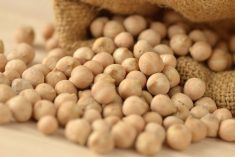CNS Canada — Large crops followed by poor export demand have led to burdensome supplies and cut into pulse prices in the U.S., which should cut into acreage ideas for peas, lentils and chickpeas in 2019, an industry official says.
“With the trade issues we’re facing right now, we have quite a surplus,” said Shannon Berndt, executive director of the Northern Pulse Growers Association in Bismarck, N.D., pointing to Indian pulse tariffs and to the ongoing trade dispute between the U.S. and China.
Read Also

Record large Canadian wheat and canola crops: Statistics Canada
Canadian wheat and canola production in 2025/26 (Aug/Jul) surpassed early expectations to hit new record highs, according to updated survey-based estimates from Statistics Canada released Dec. 4.
“Across the U.S. we will definitely see a drop in acres just due to the fact that we have such a large surplus we’re trying to work through,” she said.
“We had two years of back-to-back historic acres planted, particularly in Montana.”
With those large crops now facing export challenges, she expected pulse acres would be down in 2019 and acreage losses would likely be most noticeable in Montana, where there were more new growers.
“We have a solid base of producers here (in North Dakota) that are growing (pulses) for the agronomic and rotational value probably far more than for the price,” said Berndt.
“When the prices are really good you tend to see a lot of new growers step in, and those will be the folks who will be very hesitant to plant.”
Chickpea area saw the largest growth in the U.S. in recent years, and likely has the most room to decline in 2019. Peas, meanwhile, should benefit from increasing domestic demand.
“The silver lining to this dark cloud is that things have started picking up on the domestic side,” said Berndt, pointing to the increased demand from pea fractionation plants.
Some chickpea sales were still being made to India, despite the tariffs, while increased demand from the pet food sector was another supportive influence.
However, there are concerns that “if acres were to drop too much, that would affect any headway that’s been made.”
The ongoing partial government shutdown in the U.S. was another unknown overhanging the country’s pulse sector, as the industry had been awaiting the release of the official harvest prices for revenue insurance purposes.
“Someone at the (U.S. Department of Agriculture) worked on the data” and the numbers were released Monday night, Berndt said.
Harvest price data is used to set crop insurance payments and will help offset poor prices to some extent for those growers who took out insurance. Berndt said harvest prices will also help in making acreage decisions for this year.
“There’s certainly been some challenges thrown at us, but if we can slog through the next year we’ll see some real changes on the other side.”
— Phil Franz-Warkentin writes for Commodity News Service Canada, a Glacier FarmMedia company specializing in grain and commodity market reporting.















